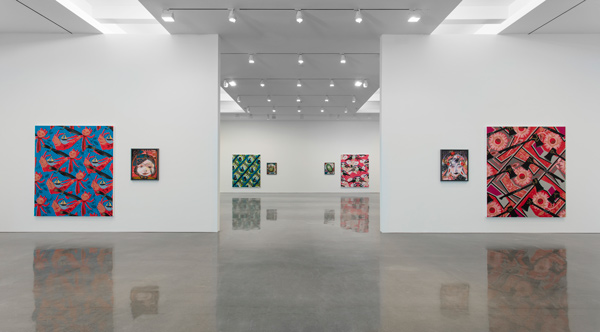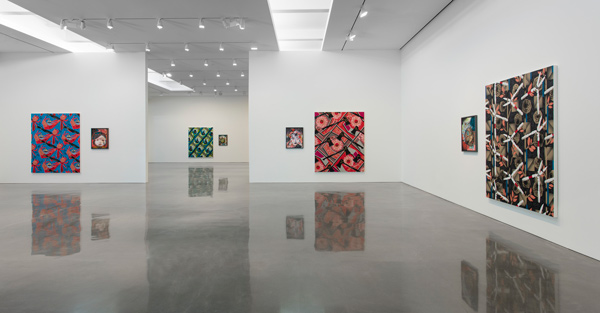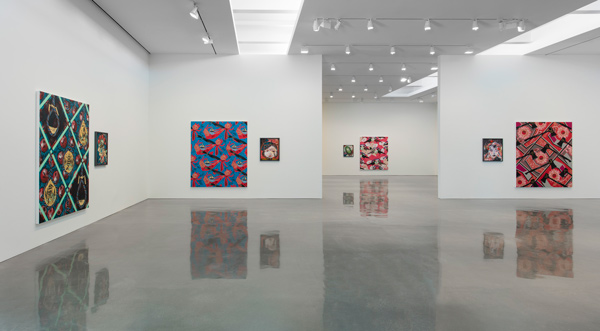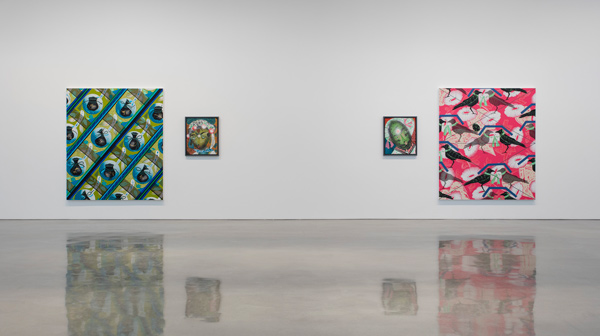Positing achievements in the decorative arts as a viable window into any culture’s zeitgeist, Lari Pittman takes his flair for generating psychosocial motifs to a genuinely exciting new place in his latest collection. As the exhibition title hints, the installation proceeds in pairs, one each of a large-scale textile-based pattern, and its accompanying bust of a person. These works are full of the densely gathered detail, the crisp black accent lines, and the rich, deep notes of the eccentric palette for which he is known. Yet despite this profusion, these new paintings are relatively minimalistic when measured on the Pittman scale, even rather reductive. The portraits are smaller, centralized compositions. The enforced discipline of the scaled-up repetition in the textile-pattern structures required refinement rather than additive exuberance. The tremendous success of all the new paintings is in large part due to the ways in which these restraints provide a single central idea with all the room it needs to breathe.

Installation view of Lari Pittman, “Portraits of Textiles & Portraits of Humans” at Regen Projects, Los Angeles. September 15 – October 27, 2018. Photo: Brian Forrest, Courtesy Regen Projects, Los Angeles
Influenced omnivorously by European decorative arts and global traditions like African commemorative textiles, Pittman is certainly interested in the collision and convergence of traditional craft’s aesthetic with current-events content. That’s kind of his thing. But for these paintings, he’s narrowed the focus of his imagination to more fully explore the decorative modality’s capacity for belying its own pleasure principles to communicate less genteel truths. The dozen textile paintings each contain one dominant image which rests on the surface of the painting, pressing against the choreographed procession of the ground it anchors in place, and creating the off-axis grids that keep it all in mind of a printed fabric. About half feature weaponry and violent motifs like hatchets, nooses, fish hooks, and garden shears; the others offer more domestic or natural-world symbolism like keys, architecture, crows, and snakes.

Installation view of Lari Pittman, “Portraits of Textiles & Portraits of Humans” at Regen Projects, Los Angeles. September 15 – October 27, 2018. Photo: Brian Forrest, Courtesy Regen Projects, Los Angeles
The human portraits correspond to the larger works, mainly in terms of palette, but also in echoed shapes and gestures, and certain flicks or swishes that are perennially Pittman. Cues and correspondences manifest in variations. For example, Portrait of a Textile (Taffeta) (all textile works: 2018, cel-vinyl, spray enamel on canvas over wood, 81 x 70 inches) features snakes in the pattern because they hiss, the way taffeta does when it moves. It’s exotic, and its partner, Portrait of a Human (Pathos, Ethos, Logos, Kairos #16) (all portrait works: 2018, cel-vinyl and spray paint over linen mounted on canvas, 26.5 x 22.5 inches), wears a turban and a vintage moustache—a snake charmer, plausibly.

Installation view of Lari Pittman, “Portraits of Textiles & Portraits of Humans” at Regen Projects, Los Angeles. September 15 – October 27, 2018. Photo: Brian Forrest, Courtesy Regen Projects, Los Angeles
While paired to indelible effect in the installation and exhibition, as in their making too, these are technically not diptychs. Perhaps the most perfect pairing is Portrait of a Textile (Brocade) and Portrait of a Human (Pathos, Ethos, Logos, Kairos #7), with its pas-de-deux of irresistible juicy reds, the vaguely soviet crisscross of hatchets in slow-motion flight, the distressed skin and spectacular styling of the tragic gypsy queen portrait, and the architectural vectors that hold it all together. Others eschew narrative and instead provoke new questions, such as what kind of civilization would make a decorative pattern out of a noose?
Lari Pittman, “Portraits of Textiles & Portraits of Humans,” September 15 – October 27, 2018, at Regen Projects, 6750 Santa Monica Boulevard, Los Angeles, CA 90038. www.regenprojects.com


